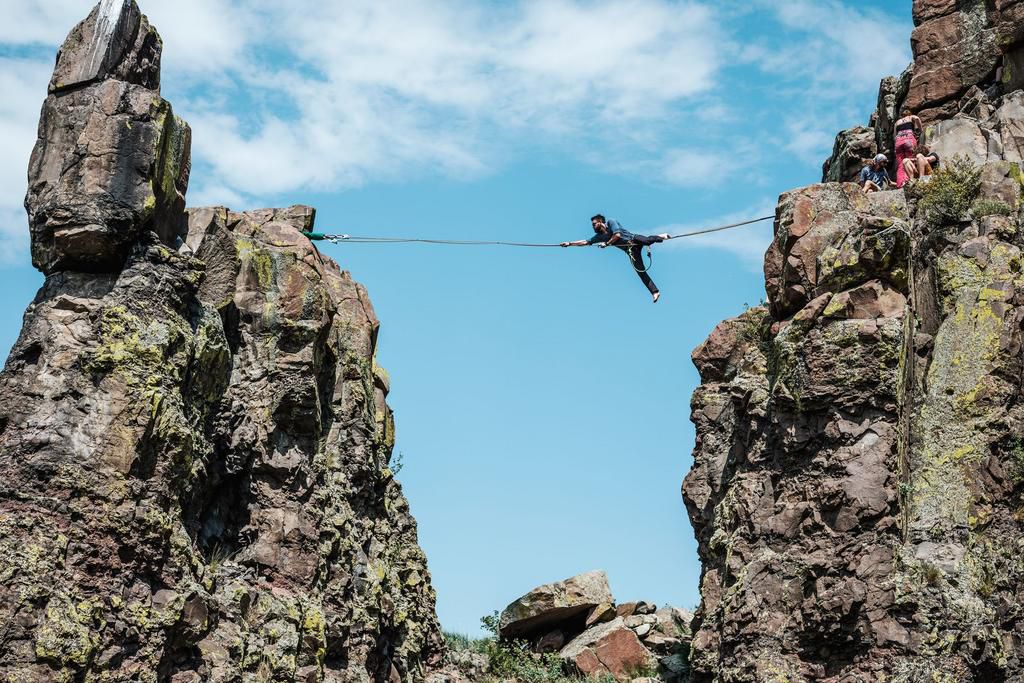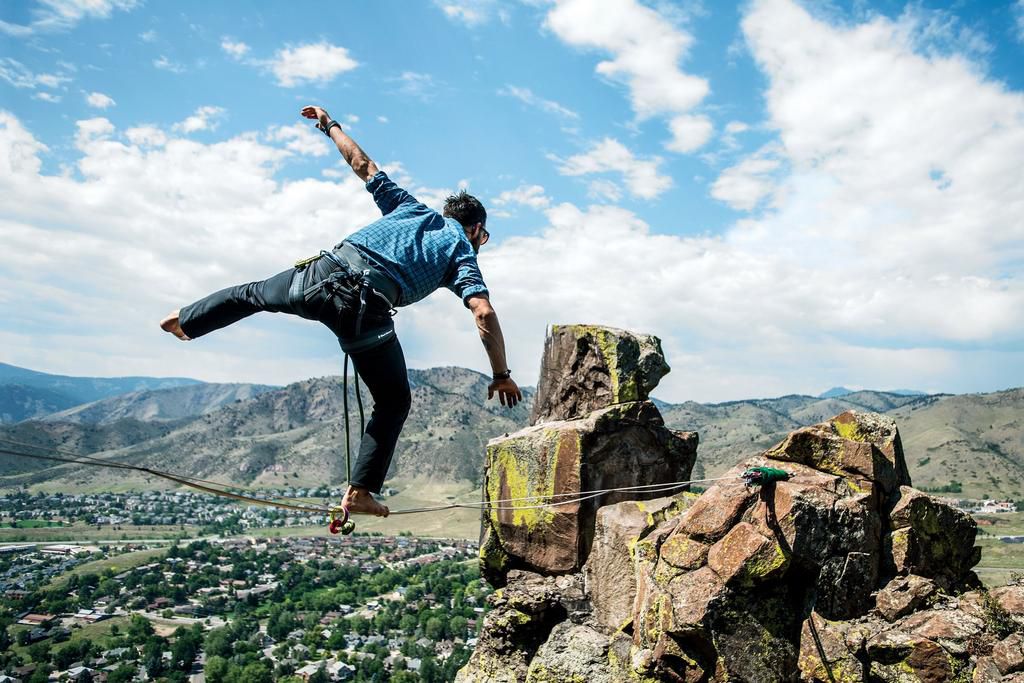AFTER ONLY 4 DAYS OF TRAINING, THIS MAN TRIED TO WALK A TERRIFYING 60-FOOT HIGH LINE
)
Fort Collins, Colorado: My batshit crazy plan is to send a highline in five days. Sending is lingo for walking all the way across without falling, and the world record is longer than a mile. Im aiming for 20 feet, a bees dick by comparison, but Ill be 60 feet in the air and relying on skills that most people take years to master. If youre a fast learner, it might not be impossible, says Dakota Collins, owner of Rocky Mountain Slackline, when I first sketch out my plan. The goal of the Adventurist, I tell him, is to discover if its possible to apply accelerated learning techniques to outdoor challenges. Flexibility, muscle control, focusthese are the skills he says Ill need to succeed, and theyre exactly the kinds of skills I rarely find time for beyond, say, yoga class twice a week. Fitbit has packed me off with a Fitbit Ionic, a new smartwatch, to try out. Dakota is amenable, but he needs me to know how hard it will be: Im going to have to reprogram your body, he says.
Our training starts strong. By the end of day one, Im taking steps on a slackline strung near the ground between two trees. When day two is done, Ive walked 50 feet without falling. The instruction is as much mental as physical. Dakota describes slacklining as active meditation. You have this line youre trying to conquer, and you do it by focusing on your breath and body.

Slow, conscious breathing turns out to be the most critical skill I need to hone. If I take a shaky step, I inhale slowly, as if through a straw. The idea is that air flows through me, seemingly straight into the line, to reestablish the fragile connection between me and the webbing. With a careful exhale, Id take my next step. I also focus my energy into my fingertips. Remember your salt shaker, Dakota says when he notices tension building in my shoulders. He wants to see my wrists twitch, as if Im shaking out grains of instability.
On the third day, Dakota introduces the skills Ill need on the highline. I spend the morning chasing the Chongo and learning to fall. In slacklining, falls are no big deal. You just land on grass and step back on the line. But on the highline you have to climb your leash, hang beneath the line with your hands and feet, and roundhouse-kick one leg out wide to create the momentum to spin onto the line. I spend all afternoon working out the logistics of that maneuver, and by the time we call it a day, Ive strained my right hip flexor and my thighs are so riddled with bruises that they look like a Rorschach test.
The last day of training is more of the same: Chongo reps, small steps, hard falls. In my excitement to try a new sport, I havent prepared myself to care so deeply about succeeding. My mindset swings between the quitter I fear I am, and the fighter I want to be. After an ice bath, I share my anxiety over a beer with Dakota. I really hope Ill be able to cross, I tell him. But I also feel like if thats my only measure of success, then Im not really learning what Im supposed to. Dakota would bust my balls if he thought I was being too earnest, and I expect a ribbing. But no. Remember this moment, he says. This is the moment you became a slacker.

Walking the slackline, my heart hovered between 100 and 110 beats per minute. Thats on the high side, but I figure Ill be fine on the highline if, through breathing and focus, I can keep my heart rate close to that. During the final challenge on day five, with the ground no longer within reach, my heart will not submit. I feel it high it in my throat, just below my dry mouth. I take a couple of early falls, clamber back up the leash. I check my Fitbit: 133 beats per minute. My body can sense the high stakes.
With each Chongo, I stand up wobblier and lose my footing before completing a step. And the falls arent pretty: On one, I plummet feet-first off the line. The 3-foot leash between my legs snaps my nuts so hard my kids will probably be born with PTSD. I scream; Dakota winces. The painful falls, fried muscles, gimpy hip, and blisters on my hands and feet dont stop me from walking, but they have undermined my confidence. Its nearly 5 p.m., our scheduled quitting time, when I try again to stand. My foot whiffs the line, and for probably the 15th time, I plunge to the bottom of my leash. Time is running out. I check my heart rate: 143. Im losing.
I can sense that Dakota is ready for me to give up. He has stopped offering words of encouragement. I am alone. On trembling arms I climb the leash above me. It takes two tries, but I flip myself over onto the line. With a deep breath, I pull myself into Chongo, flick my salt shaker. I inhale slowly into the line. Then I stand up and take a step. I fall before I can plant the second step, but at this point it doesnt matter. I fought, and the way I see it, I won. My feat wont register in the annals of highline history, but Ive regained my self-respect. Ive also lived to face the next challenge. Back home, I buy my own line, take it to the park, and string it between two trees. My Chongos getting better.
Talk the Walk
Highline
A slackline set high above the ground, so a fall could kill you if youre not using a leash attached to a harness.
Free Solo
Highlining without a harness, so if you fall, you die. Not advised.
Ball and Chain
Highlining naked with the leash tied to your penis, so if you fall, youre castrated as you die. Also not advised.
Send
To walk all the way across the line without falling.
Whipper
A fall from a highline. Some whippers are mild, but with others, the leash on your harness cuts into your legs and spins you like a yo-yo.
Heartbreak Zone
The last few feet of line, when youre close to a send but still have a few steps remaining. Mentally this can be the trickiest part of the walk.
Full Man
To send a line out and back with zero falls. For women, its known as a full babe.

)
)
)
)